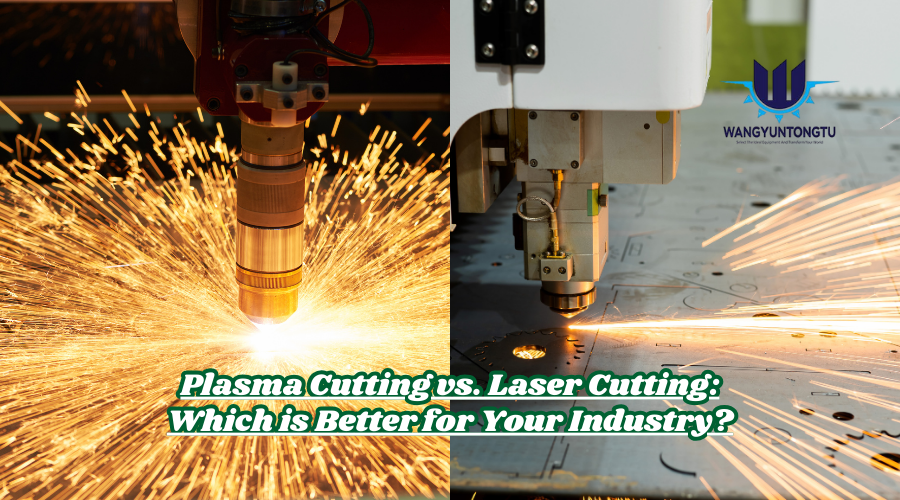Fiber, crystal, and other laser generation systems have advantages and disadvantages. Still, they are generally applied in specialized applications or scientific and research experimentation instead of mere industrial cutting and fabrication. This is because they are usually more extensive, delicate, costly, complex, and likely to fail. In this blog, we will compare two laser-cutting solutions: plasma and laser cutting. What is Laser Cutting? Laser Cutting Machines have been used in the industrial sector for many years. While using high-powered lasers for cutting and other purposes is commonly seen in science fiction films, they've also been usable as tools since 1965. Their invention is a bit more recent than that of plasma cutters. At first glance, laser cutting appears to be relatively straightforward. A laser is simply light that is concentrated and directed. How light is produced, aimed, and focused can differ. Typical lasers comprise CO2, Neodymium, and fiber laser systems, each featuring different power levels and applications. The laser used for production cutting will most often be a CO2 laser. In these lasers, a blend of gases, such as CO2, helium, and nitrogen, is held within a container. This gas blend is energized with an electrode, which activates the CO2 molecules and leads them to release photons. With ample CO2, this method produces sufficient photons to form a high-energy laser that can cut. In contrast to plasma cutting, laser cutting can be finely adjusted and perform an extensive range of tasks like cutting, engraving, surfacing, and finishing. It is capable of slicing through conductive materials such as steel, brass, and aluminum. In addition, as it doesn't conduct electricity with the workpiece, it can also slice nonconductive materials like wood, silicon, ceramic, and others. The laser can also pierce through metals harder to cut with plasma, such as tungsten and nickel. What is Plasma Cutting? Plasma cutting machines might sound like some sci-fi gadget, but they were first developed in 1957. In the following 60+ years, numerous developments have been made in the technology, both in plasma cutting itself and in the accompanying mechanisms, such as computer and robotic controls. In plain language, it traps and energizes a tornado inside a torch. Essentially, an electric arc is formed by a cutting torch. At the same time, a specific type of gas, typically an inert gas such as argon or nitrogen, is forced through the torch in a spiral. The gas goes through the arc and gets ionized and charged as it heats it to a temperature of up to 20,000 degrees C. In scientific terms, it's not even gas but the fourth energetic state of matter, plasma. This superheated ionized gas/plasma is then expelled out of the torch by the pressure of the gas behind it and by its thermal expansion. This gas is channeled and concentrated onto the narrow region where you wish to cut, quickly melting the material in this region. The gas pressure blows off the molten material, creating a void and cutting through the workpiece. One of the most considerable caveats to plasma cutting is the electrical arc. Like arc welding, the arc is created by the contact and short-circuit between the workpiece and the torch. As a result, only conductive metals can be cut using plasma torches. Plasma torches are great for cutting steel, aluminum, brass, or copper but won't cut wood, ceramic, silicon, or plastic. Detailed Comparison of Laser Cutting and Plasma Cutting Accuracy Laser beams in a laser-cutting machine can be highly focused and accurate. This renders them considerably more accurate overall than plasma cutters, which are relatively high-energy and less precise. Plasma cutters leave a wider kerf for the cut and thus a wider hole in the material, having less accuracy. Versatility As a directed energy source, laser cutters can slice up anything that will absorb photons. Based on the workpiece's electrical conductivity, plasma cutters can only machine conductive materials. The limitation of laser cutters in this regard is that some metals are very reflective; they don't take in much, if any, photons, so they are extremely hard or impossible to machine with lasers, which get reflected away from the material. Another aspect in which plasma cutters outperform laser cutters is cutting through thick materials. Most standard laser cutters only cut materials as thick as roughly 19mm with decent speed, precision, and effectiveness. In contrast, plasma cutters can cut materials as thick as 38mm without any trouble. That being said, higher-powered lasers are capable of far more. There are potent lasers that will cut through almost anything, regardless of how thick, and even cut material from more than a mile away. These are impractical; they're being created more as military weapons and scientific test devices than manufacturing equipment. Plasma cutters use the same general design as welders. Indeed, many high-end welding machines can also perform plasma cutting by simply flipping a switch. Laser cutting, on the other hand, is nearly always done with a robotic CNC machine, and there are hardly any handheld laser tools. This sort of thing is the closest you can come, and it is used for engraving, not cutting. Cost Cost is among the most significant differences between laser and plasma cutting. Laser cutters tend to be costly. The most basic, low-power, hobby-level machines may cost between $500 and $4,000; in contrast, industrial-use laser-cutting systems may cost up to $200,000. Plasma cutters are often somewhat cheaper to get started. Introductory-level handheld plasma cutting systems can be as little as $200-$300. Much more extensive systems, including industrial CNC machines, can cost between $5,000 and $20,000. Past a certain point, you're also paying more for the surrounding robotics and other equipment than the plasma cutter itself. Operating expenses, however, turn around in favor of lasers. While the initial cost is more significant, laser cutters are cheaper in terms of power to run, and they virtually have no consumables compared to plasma cutters. Plasma cutters take more power to make equivalent cuts, and they need consumables in the torch and the gases utilized to create the plasma. Safety Safety is a primary issue in all uses of high energy. Laser and plasma cutting both employ high energy and heat to cut material, and this can result in molten material or other material spewing about, sparks raining down on the surrounding area, and fumes from burning material in the air. Plasma cutting is more unsafe and more dangerous than laser cutting in two aspects. The first is that since it has a shielding gas that creates the plasma and the typical fumes, your device also deposits argon, helium, nitrogen, or other substances into the air. That's another potential risk. While these gases are not poisonous, they will create oxygen displacement issues and other risks. The second is radiation. High-energy plasma generation releases a large quantity of radiation into the surrounding atmosphere of the cutting application. This is not an extreme danger like Chornobyl, but it's still possible, mainly to frequent users. It also harms vision and leads to surface burns to the skin, similar to a sunburn. Additionally, this radiation can interfere with electromagnetic signals such as radio, WiFi, and other technologies. Conclusion Ultimately, plasma and laser cutting have advantages that make it hard to say one is definitively better. Laser cutting is excellent for making exact cuts and cutting materials that aren't conductive metals. On the other hand, the high upfront cost is more expensive, the inability to have handheld control makes it poorer for single tasks, and the relative failure to cut thicker pieces of material is a real handicap. Plasma cutting, on the other hand, is inexpensive and more straightforward, and a perfectly operational option exists to source welders with the capability for plasma cutting quickly and easily. Although more dangerous to the operator's safety, it has the potential for automation. Yet, the machines' flexibility and relatively low costs make them preferable for smaller and mid-sized shops that will not require significant fabrication banks.












